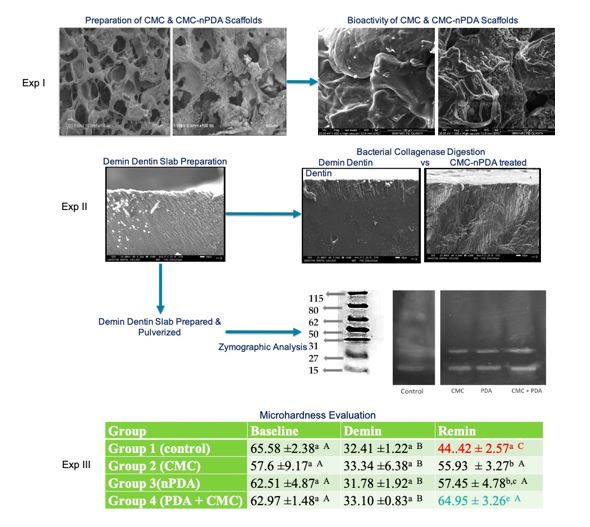Video Article Open Access
Functional Remineralization Potential of Carboxymethyl Chitosan with & without Nano-polydopamine on Demineralized Dentin
Sekar Mahalaxmi*, Saravanakarthikeyan Balasubramaniam, Madhana Madhubala, Palmoor Santosh Kumar
Department of Conservative Dentistry & Endodontics, SRM Dental College, SRM Institute of Science & Technology, Ramapuram 600089, Chennai
Vid. Proc. Adv. Mater., Volume 3, Article ID 2212375 (2022)
DOI: 10.5185/vpoam.2022.12375
Publication Date (Web): 27 Nov 2023
Copyright © IAAM
Graphical Abstract

Abstract
The aim of this study was to evaluate the remineralization and collagen stabilization potential of carboxymethyl chitosan (CMC) with and without nano polydopamine (nPDA). Carboxymethyl chitosan (CMC) and nano polydopamine (nPDA) biomaterials were prepared from chitosan and L-DOPA respectively. nPDA was mixed with CMC and freeze dried to form a scaffold that was then immersed in SBF for 7 days, and characterized for their components, size and bioactivity using SEM-EDX, XRD and FTIR. For MMP inhibition activity, pulverized dentin slabs were demineralized, treated with solutions of CMC, nPDA and CMC-nPDA combination for one min; following which dentin protein supernatants were subjected to zymographic analysis. Further, demineralized dentin slabs pretreated with the respective solutions were subjected to bacterial collagenase digestion procedure for one and 16 hours, and evaluated under FESEM at 50x magnification for evaluation of dentinal tubules and intertubular dentin. To evaluate dentin mineralization potential, dentin slabs of 1x1 mm were prepared, demineralized by acid etching and immersed in solutions of CMC, nPDA and CMC-nPDA combination for 48 hours. Baseline, demin and remin microhardness (MH) were checked using Vickers microhardness tester. MH data was statistically analysed using one way ANOVA and Games-Howell Post Hoc test.
CMC-nPDA scaffold showed apatite formation on the scaffold surface at 7 days, post immersion. All the three experimental solutions showed complete disappearance of collagenolytic enzyme bands characteristic of MMP-2 and MMP-9 inhibitory activity. FESEM evaluation showed complete resistance to bacterial collagenase digestion as opposed to the extensive collagen destruction in untreated dentin slabs. Amongst the test groups, CMC-PDA resulted in better collagen crosslinking than CMC and PDA, as evidenced with the presence of an increased intact demineralized dentin layer and preservation of adjacent dentinal tubules at both the tested time intervals. Regarding dentin mineralization, all experimental groups showed significantly higher microhardness values than the demin group (p<0.05). The combination solution CMC-nPDA showed significantly higher microhardness values post remineralization (p < 0.05) when compared to CMC and nPDA alone, with no significant differences among them (p > 0.05). All the groups showed no significant difference in their microhardness values when compared to the baseline values indicating remineralization of dentin slabs.
To conclude, the above experiments prove that CMC in combination with nPDA results in remineralization preserving the organic collagen, thus stabilizing the collagen for functional remineralization of demineralized dentin in vitro.
Keywords
Remineralisation; collagen stability; carboxymethyl chitosan; nanopolydopamine.
References
- Liu Y, Zhang Z, Lv H, Qin Y, Deng L.; Journal of Bioactive and Compatible Polymers. 2018, 33(2),134-45.
- Sagar N, Soni VP, Bellare JR; Journal of Biomedical Materials Research Part B: Applied Biomaterials. 2012, 100(3), 624-36.
- Wang R, Guo J, Lin X, Chen S, Mai S.; RSC Advances, 2020,10(22), 12970-81.
- Zhou YZ, Cao Y, Liu W, Chu CH, Li QL.; ACS Applied Materials & Interfaces, 2012, 4(12), 6901-10.
Biography
I am a tenured Professor and Chair, Department of Conservative Dentistry and Endodontics, SRM Dental College, Chennai, India since 2006. I have about 118 original scientific publications in major scientific journals (h-index 21). I received my Bachelors’ (1980) and Masters’ Degree (1986) from Gujarat University. I have been in academia since 1990. I have received “Prof JG Kannapan” award (2016) for best research article by Indian Society of Dental Research (Indian Division of International Association for Dental Research), Dhronacharya Award (2018) a State Award for teaching excellence, and IADR Cariology Group Research Travel Award (2019). I am also resource faculty for National Centre for Nano-Science and Nano-Technology (NCNSNT), Madras University, India. My research group have filed 5 patents. I have authored a book ‘Materials used in Dentistry’, published by Wolters Kluwer India, with the second edition released in 2018. I have also contributed book chapters in ‘Essentials of Endodontics’, published by Quintessence Publications and ‘Textbook of Conservative and Restorative Dentistry’, published by CBS Publishers. I have received a research grant from Department of Science and Technology, Govt. of India for Rs. 34.82 lakhs (approx. USD $45000) for ‘Development of Apex Locating, Anti-microbial and Adaptive Gutta Percha Points for Root Canal Applications’.
Video Proceedings of Advanced Materials

Upcoming Congress



